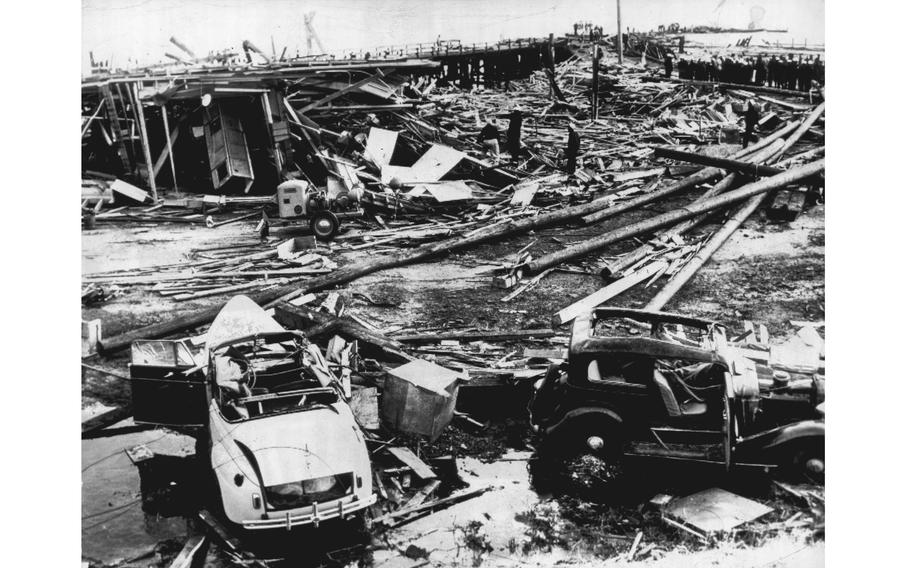
Cars parked near the dock, seen here July 18, 1944, were blown apart, and metal was found more than a mile away after the Port Chicago munitions explosion. (Bay Area News Group/TNS)
CONCORD, Calif. (Tribune News Service) — During World War II, the Port Chicago Naval Magazine was a bustling hub where hundreds of African American sailors — segregated from their white counterparts — toiled as “stevedores,” loading cluster bombs, ammunitions, mines and other explosives onto Navy ships bound for the Pacific theater.
But tragedy struck shortly after 10 p.m. on July 17, 1944, when lax military safety protocols sparked a massive explosion that effectively vaporized nearby cargo ships and facilities on the base along the shores of Suisun Bay — instantly killing 320 sailors and civilians, who were predominantly young African American men in their late teens to early 20s, and injuring nearly 400 others. Only a few bodies were ever recovered.
The blast propelled a massive fireball into the night sky, sent a shock wave of flying shrapnel that flattened Port Chicago and measured 3.4 on the Richter scale in nearby Berkeley.
In honor of the 80th anniversary Wednesday, a four-day “Port Chicago Weekend” will meld education and entertainment July 18-21 to honor the catastrophe — the deadliest military disaster on mainland American soil during World War II.
Scores of events are planned in Concord, Pittsburg, Vallejo and Oakland, where attendees can enjoy live music, watch a theatrical performance of the “Port Chicago 50” play, and listen to firsthand accounts from relatives of the service members who perished eight decades ago.
While the National Park Service holds a commemoration ceremony every year at the Port Chicago Naval Magazine National Memorial in Concord, Yulie Padmore, director of the Port Chicago Alliance, said she helped spearhead this year’s events with community organizers, historians and performers to increase engagement and broaden the appeal of this important Bay Area history.
“After all, the Bay Area’s role in advancing civil rights in our nation is something to celebrate, and we hope these events will be entertaining as well as educational,” said Padmore, who first learned about this history eight years ago from the East Bay Regional Park District’s efforts to spotlight the naval base. “In addition to racial integration, the Port Chicago explosion and its aftermath catalyzed reforms that have since influenced labor laws and practices, ensuring better protections for workers and fostering a culture of safety and fairness that continues to shape our society today.”
While the exact cause of the explosion was never determined, historical records pointed blame at Navy leaders for circumventing proper protocol while training the majority of African American sailors to load munitions at Port Chicago.
In the aftermath, 50 Black men refused to continue loading munitions. They were subsequently court-martialed at Yerba Buena Island in a mass trial and convicted of mutiny, sentenced to punishments that ranged from confinement to years of hard labor.
By 1946, most of the convicted sailors were released and granted clemency, and the Navy became the first of the U.S. armed forces to desegregate. All branches of the U.S. armed forces followed suit by 1948.
However, the Port Chicago 50 were never fully exonerated for disobeying wartime orders. Several efforts by federal legislators since 1990 — including East Bay U.S. Representatives Mark DeSaulnier, John Garamendi and Barbara Lee — to reverse course have been unsuccessful.
Thurgood Marshall, a then- NAACP lawyer and future Supreme Court Justice, swiftly organized national petitions and protests. In October 1944, he said that the Navy should be tried, instead, for its “whole vicious policy toward Negroes. Negroes in the Navy don’t mind loading ammunition. They just want to know why they are the only ones doing the loading.”
Starting in 2020, continued advocacy from several community organizations — such as the East Bay Black Employee Collective, Citizens for Historical Equity, Friends of Port Chicago National Memorial, East County NAACP, United Veterans Council, Contra Costa County Bar Association, and the Port Chicago Taskforce — helped facilitate the naming of the 2,500-acre Thurgood Marshall Regional Park – Home of the Port Chicago 50. Additionally, more than a dozen Bay Area cities and government agencies have passed resolutions calling for exoneration.
While survivors of the blast such as Ray Ross, TJ Hart, Morris Soublet, Freddie Meeks, Sammy Boykin and Percy Robinson have since passed, Padmore said this recent advocacy has already helped Port Chicago Alliance connect with additional relatives of the former service members.
She said organizers hope to use the 80th anniversary to draw attention to the legacy of the tragedy and the Bay Area’s subsequent role in the national campaign for racial equality.
“The Port Chicago sailors’ non-violent civil disobedience — an act which would later become a hallmark of the civil rights movements of the 1950s and ’60s — directly resulted in the desegregation of our Armed Forces,” Padmore said, noting that the sailors’ protest occurred a full decade before Rosa Parks, the Greensboro sit-in and Brown v. Board of Education. “It’s truly hard to overstate its importance to the advancement of civil rights in our nation, and I’m so proud to know this happened right here in the Bay Area.”
©2024 MediaNews Group, Inc.
Visit at mercurynews.com.
Distributed by Tribune Content Agency, LLC.